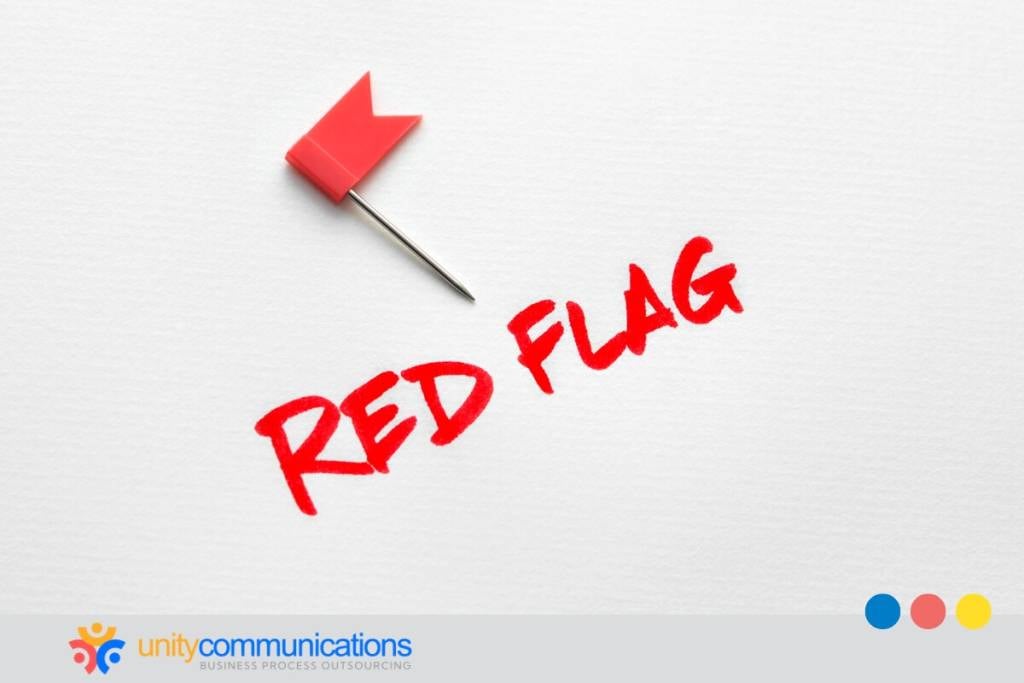Table of Contents
Outsourcing is a strategic tool for streamlining operations and optimizing costs through external expertise. However, beneath the benefits lie potential pitfalls that can derail even the most meticulously planned business process outsourcing (BPO) partnership.
Recognizing the early warning signs in outsourcing is crucial for your business. Understanding them can empower you to proactively address issues before they escalate and keep your outsourcing venture on track and beneficial.
Read on to learn more about outsourcing red flags to watch out for.
Outsourcing red flags to watch out for

To begin, what is BPO? It is the strategy of delegating business functions to a third party. Partnering with a high-performing outsourcing provider can bring significant advantages to your business. It enhances productivity, leading to higher returns on investment (ROI). It also streamlines processes, improves efficiency,, and reduce costs.
Choosing the right outsourcing firm is essential to maximize these benefits. However, make sure to be vigilant about red flags when selecting a third-party service provider to avoid making a detrimental choice.
Neglecting warning signs during the outsourcing partnership can result in poor service quality, data security vulnerabilities, delays, and communication breakdowns. All these waste time, effort, and financial resources. Identifying and addressing these indicators preempts issues.
By remaining attentive to these warning signals and conducting due diligence, you can make an informed decision when selecting a potential outsourcing partner and managing your BPO partnership.
Here are common outsourcing red flags to watch out for:
1. Inconsistent performance and quality control issues
Inconsistent performance and quality control issues are some of the significant outsourcing red flags to watch when hiring a BPO firm. They can significantly hurt business operations.
Here are some warning signs:
- Noticeable fluctuations in the quality and timeliness of deliverables compared to agreed-upon standards
- Difficulty in maintaining clear and effective communication channels, leading to misunderstandings or missed expectations
- Little to no visibility into processes, performance metrics, or access to reports that gauge service quality
Mitigate this BPO risk and significant drawback by defining measurable key performance indicators (KPIs) at the outset of the partnership. Regularly reviewing these metrics ensures that the BPO team aligns with your expectations and the agreed-upon service levels.
Introduce robust quality assurance processes, including regular audits, quality checks, and feedback loops to monitor performance and maintain consistency. Consider establishing clear escalation protocols for addressing issues that affect service quality. Lastly, define responsibilities and timelines for resolving issues to prevent prolonged disruptions.
2. Missed deadlines
Delayed deliverables hinder business operations by affecting subsequent tasks or projects that depend on timely inputs. Consistently missing deadlines harms your company’s reputation, leading to stakeholder dissatisfaction and poor customer service.
Depending on the cause of the delay, financial repercussions also occur. These can range from penalties for breaching contractual agreements to revenue loss due to delayed product launches or service rollouts.
Here’s how to identify this problem before it escalates:
- Noticeable patterns of deadlines being missed or extended beyond agreed-upon timelines
- Consistent reliance on excuses or justifications (e.g., resource constraints, unexpected issues) for failing to meet deadlines
- Tangible disruptions to your internal workflow or project schedules due to delayed deliverables from the outsourcing partner
Address this problem by regularly monitoring progress against deadlines. Project management tools can help track milestones and flag any deviations early.
Before the partnership begins, clearly define project timelines and milestones and document them in the contract or service-level agreement (SLA). Additionally, include clear clauses that outline consequences for missed deadlines, such as penalties or provisions for dispute resolution.
3. Weak technology and infrastructure
Outdated technology might slow down productivity and damage the quality of service delivery. Weak technology infrastructure prevents providers from increasing workloads or adapting to evolving business needs, leading to delays or service disruptions.
Older technologies are also more vulnerable to cybersecurity threats, potentially compromising sensitive data and exposing your business to data breaches. If your workforce size ranges from 1,001 to 5,000 employees, a data breach can cost an average of $4.87 million.
Some warning signs include the following:
- The outsourcing company uses technology solutions that are outdated, unsupported, or not aligned with current industry standards.
- The BPO vendor does not adopt innovative technology or is reluctant to invest in new platforms that can enhance efficiency, security, or performance.
- The service provider lacks robust information technology (IT) infrastructure, which leads to downtime, performance issues, or an inability to scale operations effectively.
Conduct performance tests to ensure a potential BPO partner’s technological capability. Inquire about its technology stack, software versions, security measures, and plans for upgrades.
If possible, discuss future-proofing strategies with the provider. Ask about their scalability plans and ability to accommodate business growth or changes in requirements.
4. High employee turnover rates
High turnover rates lead to disruptions in service delivery, as new team members require time to ramp up and understand project specifics. In fact, newly hired employees take six or more months to be fully productive. Continual turnover also results in the loss of domain knowledge, which influences service quality.
Lastly, constantly managing transitions and onboarding new team members can strain resources and detract focus from core business objectives.
Some factors to identify this red flag include:
- Noticeable turnover among key personnel or team members assigned to your project, leading to inconsistencies in service delivery
- Limited tenure of third-party employees, indicating potential issues with job satisfaction, management practices, or organizational culture
- Difficulty in maintaining continuity and knowledge transfer when core team members leave
Before partnering with a vendor, request turnover statistics and compare them with industry benchmarks. High turnover rates that exceed norms warrant closer scrutiny.
Inquire about the provider’s succession planning strategies. Ensure it has contingency plans to manage transitions smoothly and minimize disruptions in service.
5. Thin portfolio
In outsourcing, a thin portfolio refers to a lack of a diverse track record or substantial past projects that an outsourcing provider can showcase. It has few documented case studies, client testimonials, or references to showcase its work quality.
Insufficient industry experience might lead to misalignment in business goals, processes, and customer expectations. The provider’s scalability and adaptability are also uncertain. The firm might be prone to delays, inefficiencies, or subpar outcomes.
Address this red flag with these strategies:
- Assess the provider’s experience within your industry. Evaluate its knowledge of industry-specific regulations, best practices, and challenges to gauge suitability.
- Based on your business needs, discuss the provider’s capacity to scale operations. Inquire about its infrastructure, workforce capabilities, and previous experience handling projects of similar scope and complexity.
- Assess the skills and expertise of the team members assigned to your project. Inquire about their qualifications, certifications, and relevant experience to ensure they can deliver the required outcomes.
The bottom line

Outsourcing red flags to watch out for include weak technology, high attrition rate, unclear strategies, and hidden costs. Disregarding these can result in a significant waste of resources.
Meticulously assess outsourcing partners and monitor vendor performance. This step identifies and addresses uncertainties, mitigates risks, and fosters a mutually advantageous partnership.
Let’s connect and discuss how you can effectively navigate outsourcing and succeed in your plans with Unity Communications!




